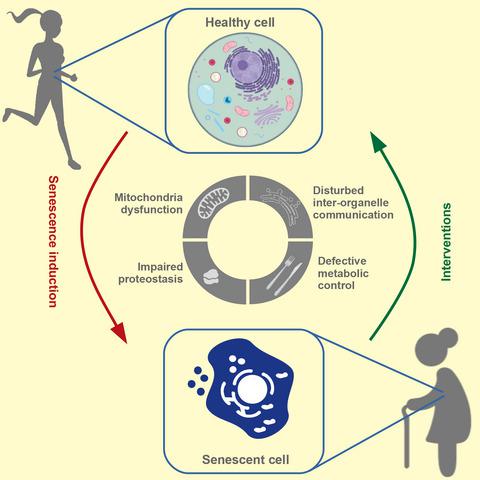Our official English website, www.x-mol.net, welcomes your
feedback! (Note: you will need to create a separate account there.)
Targeting cellular senescence based on interorganelle communication, multilevel proteostasis, and metabolic control
The FEBS Journal ( IF 5.5 ) Pub Date : 2020-11-17 , DOI: 10.1111/febs.15631 Maria Cavinato 1, 2 , Corina T Madreiter-Sokolowski 3, 4 , Sabrina Büttner 5, 6 , Markus Schosserer 7, 8 , Werner Zwerschke 1, 2 , Sophia Wedel 1, 2 , Johannes Grillari 7, 8, 9 , Wolfgang F Graier 4, 10 , Pidder Jansen-Dürr 1, 2
The FEBS Journal ( IF 5.5 ) Pub Date : 2020-11-17 , DOI: 10.1111/febs.15631 Maria Cavinato 1, 2 , Corina T Madreiter-Sokolowski 3, 4 , Sabrina Büttner 5, 6 , Markus Schosserer 7, 8 , Werner Zwerschke 1, 2 , Sophia Wedel 1, 2 , Johannes Grillari 7, 8, 9 , Wolfgang F Graier 4, 10 , Pidder Jansen-Dürr 1, 2
Affiliation

|
Cellular senescence, a stable cell division arrest caused by severe damage and stress, is a hallmark of aging in vertebrates including humans. With progressing age, senescent cells accumulate in a variety of mammalian tissues, where they contribute to tissue aging, identifying cellular senescence as a major target to delay or prevent aging. There is an increasing demand for the discovery of new classes of small molecules that would either avoid or postpone cellular senescence by selectively eliminating senescent cells from the body (i.e., ‘senolytics’) or inactivating/switching damage-inducing properties of senescent cells (i.e., ‘senostatics/senomorphics’), such as the senescence-associated secretory phenotype. Whereas compounds with senolytic or senostatic activity have already been described, their efficacy and specificity has not been fully established for clinical use yet. Here, we review mechanisms of senescence that are related to mitochondria and their interorganelle communication, and the involvement of proteostasis networks and metabolic control in the senescent phenotype. These cellular functions are associated with cellular senescence in in vitro and in vivo models but have not been fully exploited for the search of new compounds to counteract senescence yet. Therefore, we explore possibilities to target these mechanisms as new opportunities to selectively eliminate and/or disable senescent cells with the aim of tissue rejuvenation. We assume that this research will provide new compounds from the chemical space which act as mimetics of caloric restriction, modulators of calcium signaling and mitochondrial physiology, or as proteostasis optimizers, bearing the potential to counteract cellular senescence, thereby allowing healthy aging.
中文翻译:

基于细胞间通讯、多级蛋白质稳态和代谢控制的靶向细胞衰老
细胞衰老是由严重损伤和压力引起的稳定细胞分裂停滞,是包括人类在内的脊椎动物衰老的标志。随着年龄的增长,衰老细胞在各种哺乳动物组织中积累,在那里它们导致组织衰老,将细胞衰老确定为延缓或预防衰老的主要目标。人们越来越需要发现新类型的小分子,这些小分子可以通过选择性地清除体内的衰老细胞(即“senolytics”)或灭活/转换衰老细胞的损伤诱导特性(即, 'senostatics/senomorphics'),例如与衰老相关的分泌表型。尽管已经描述了具有抗衰老或抗衰老活性的化合物,它们的疗效和特异性尚未完全确定用于临床。在这里,我们回顾了与线粒体及其细胞器间通讯相关的衰老机制,以及蛋白质稳态网络和代谢控制在衰老表型中的参与。这些细胞功能与细胞衰老有关体外和体内模型,但还没有被充分利用来寻找新的化合物来对抗衰老。因此,我们探索将这些机制作为新机会来选择性消除和/或禁用衰老细胞以实现组织再生的可能性。我们假设这项研究将提供来自化学空间的新化合物,它们充当热量限制的模拟物、钙信号传导和线粒体生理学的调节剂,或作为蛋白质稳态优化剂,具有抵抗细胞衰老的潜力,从而实现健康的衰老。
更新日期:2020-11-17
中文翻译:

基于细胞间通讯、多级蛋白质稳态和代谢控制的靶向细胞衰老
细胞衰老是由严重损伤和压力引起的稳定细胞分裂停滞,是包括人类在内的脊椎动物衰老的标志。随着年龄的增长,衰老细胞在各种哺乳动物组织中积累,在那里它们导致组织衰老,将细胞衰老确定为延缓或预防衰老的主要目标。人们越来越需要发现新类型的小分子,这些小分子可以通过选择性地清除体内的衰老细胞(即“senolytics”)或灭活/转换衰老细胞的损伤诱导特性(即, 'senostatics/senomorphics'),例如与衰老相关的分泌表型。尽管已经描述了具有抗衰老或抗衰老活性的化合物,它们的疗效和特异性尚未完全确定用于临床。在这里,我们回顾了与线粒体及其细胞器间通讯相关的衰老机制,以及蛋白质稳态网络和代谢控制在衰老表型中的参与。这些细胞功能与细胞衰老有关体外和体内模型,但还没有被充分利用来寻找新的化合物来对抗衰老。因此,我们探索将这些机制作为新机会来选择性消除和/或禁用衰老细胞以实现组织再生的可能性。我们假设这项研究将提供来自化学空间的新化合物,它们充当热量限制的模拟物、钙信号传导和线粒体生理学的调节剂,或作为蛋白质稳态优化剂,具有抵抗细胞衰老的潜力,从而实现健康的衰老。










































 京公网安备 11010802027423号
京公网安备 11010802027423号